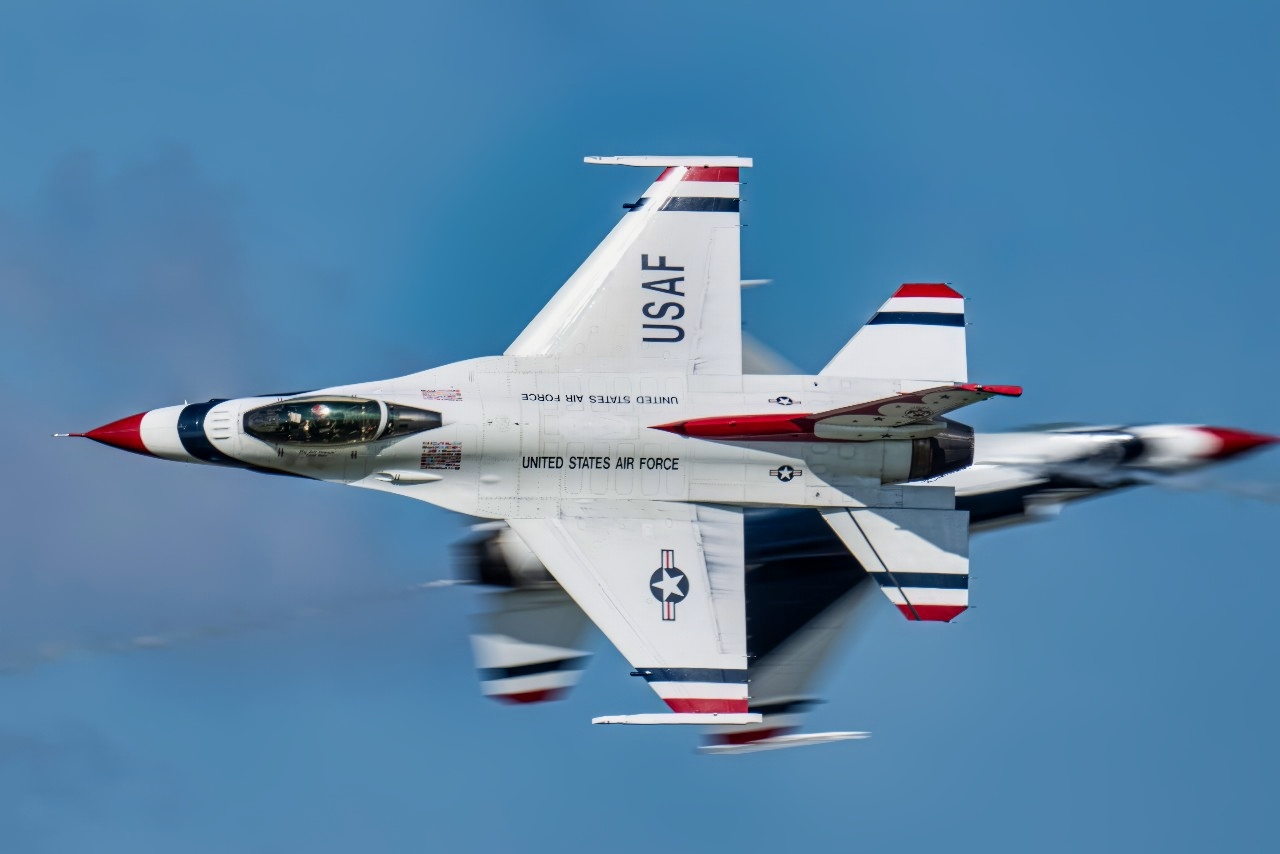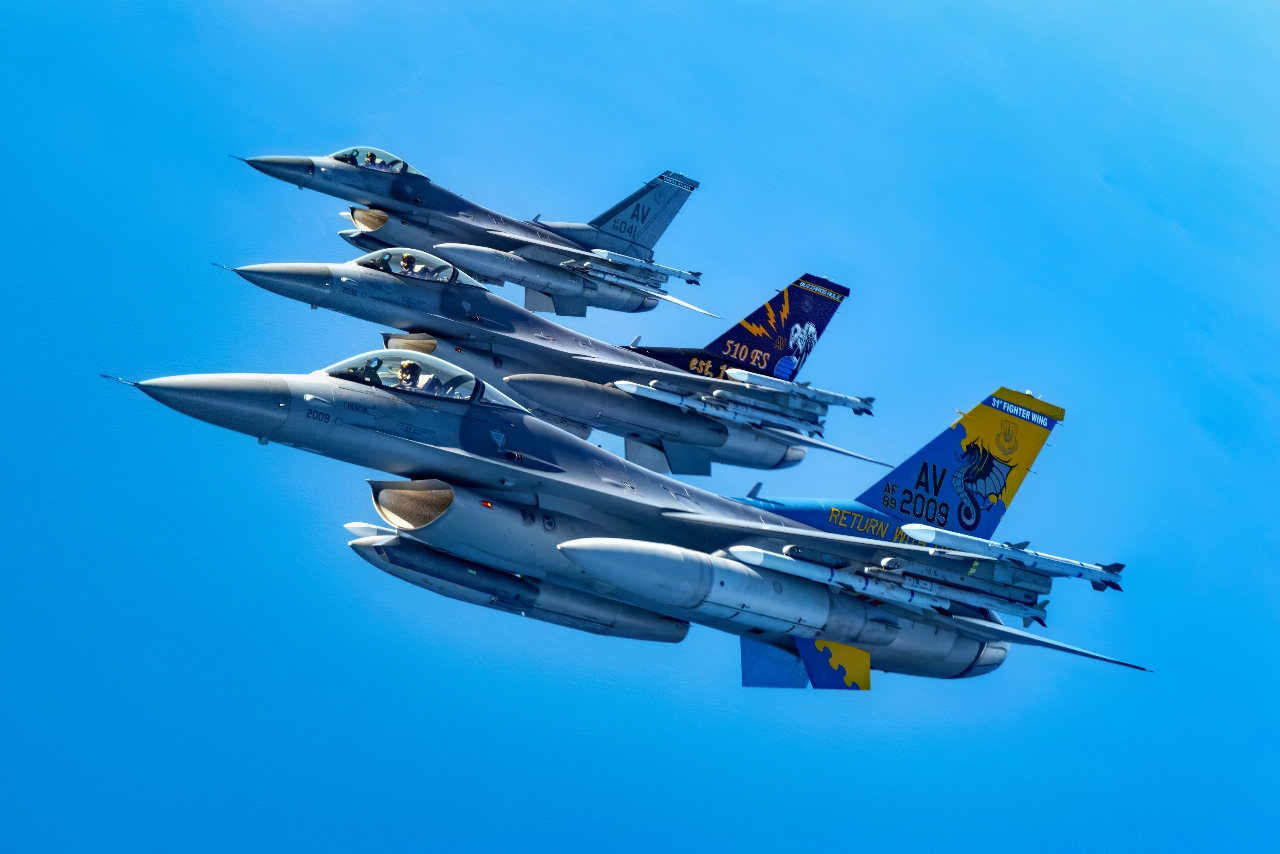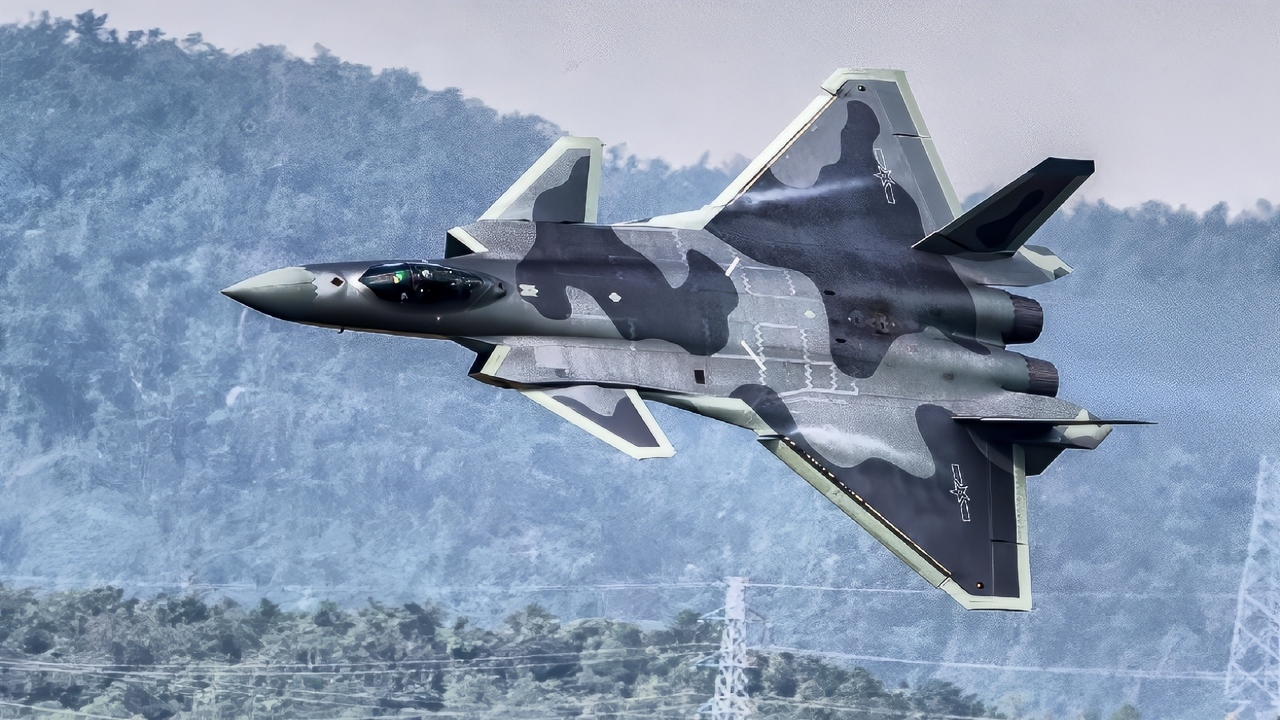Key Points Summary – Taiwan’s upgraded F-16V Viper brings AESA radar, modern EW, and AIM-120D/AIM-9X to a proven, agile airframe.
-China’s J-20 Mighty Dragon counters with low-observable design, long-reach sensors, and internal carriage of PL-15/PL-10.

The United States Air Force Air Demonstration Squadron “Thunderbirds” perform at the Defenders of Liberty Airshow at Barksdale Air Force Base, Louisiana, March 29-30, 2025. The Thunderbirds perform at air shows across the country to showcase the capabilities of the United States Air Force, its Airmen, and the F-16 Fighting Falcon. During World War II, Barksdale served as a major bomber training base, and it has since become the home of the 2nd Bomb Wing, the oldest bomb wing in the Air Force. (U.S. Air Force photo by Tech. Sgt. Keith James)
-In beyond-visual-range fights, the J-20’s stealth and passive sensing likely secure first detection/first shot, tilting outcomes its way. Inside visual range, the F-16V’s agility and high-off-boresight weapons narrow the gap—if it can survive entry to the merge.
-Networked enablers (AWACS, F-35, ground-based sensors, datalinks, and EW) will matter as much as platform specs; doctrine and pilot training could be decisive.
F-16V vs J-20: Can Taiwan’s Viper Beat China’s Mighty Dragon?
The F-16 Block 70/72 (commonly referred to as the F-16V Viper) is one of the newest and most advanced variants of the F-16 family. It incorporates newer avionics, an improved cockpit, and all the upgrades from its predecessors.
According to the designers, it is one of the most advanced fourth-generation fighters. The F-16V is operated by many air forces, including the Taiwanese Air Force, which aims to upgrade its entire fleet of 141 F-16s to the V variant.

Three F-16 Fighting Falcons from the 31st Fighter Wing fly above Aviano Air Base, Italy, November 21, 2024. The F-16’s enduring appeal lies in its technological relevance, with continual upgrades to avionics, radar systems and weaponry ensuring it remains a formidable force in modern air warfare. (Courtesy photo by Frank Crebas)
In contrast, the PLAAF flies the Chengdu J-20 Mighty Dragon, a fifth-generation stealth fighter currently being mass-produced for the PLAAF.
In the event of an all-out war between China and Taiwan, the J-20 and F-16V will likely meet each other in combat, but which one would be victorious?
The F-16V Viper Meets the Mighty Dragon
The F-16V retains the classic airframe of the original F-16. Still, it incorporates modern upgrades such as the AN/APG-83 AESA radar, advanced electronic warfare systems, and compatibility with the latest air-to-air and air-to-ground munitions.
It is powered by either the GE F110-GE-129 or the Pratt & Whitney F100-PW-229 engine, giving it a top speed of over Mach 2 and a thrust-to-weight ratio of around 1.2.
Its radar cross-section is relatively large, around 3 square meters, making it easily detectable by modern radar systems. Despite this, the F-16V is highly maneuverable, with a high roll rate and a fly-by-wire system that allows for precise control in dogfights.
The J-20, by contrast, is a much larger and heavier aircraft, with a length of over 20 meters and a wingspan of 13.5 meters. Twin WS-10C engines power it, or the more advanced WS-15 engines, which are expected to provide supercruise capability and a higher thrust-to-weight ratio.

Secretary of the Army, Hon. Dan Driscoll, flies in an F-16 assigned to the 121st Fighter Squadron, 113th Wing, District of Columbia Air National Guard in a familiarity flight at Joint Base Andrews, MD, May 29, 2025. As the Secretary of the Army, Hon. Driscoll has been delegated the responsibility of command of the District of Columbia National Guard by the President of the United States. (U.S. Army photo by Sgt. David Resnick)
The J-20’s design emphasizes stealth, with features such as diverterless supersonic intakes, radar-absorbent materials, and internal weapons bays.
Its median radar cross section is estimated to be around 0.5 square meters (depending on the frequency and angle) or less, making it significantly more challenging to detect than the F-16V.
Avionics
In terms of sensors and situational awareness, the F-16V is equipped with the AN/APG-83 AESA radar, which offers a detection range of approximately 180 kilometers against a target with a 3-square-meter radar cross-section.
It also features the Viper Shield electronic warfare suite, Link-16 data link, and optional infrared search and track (IRST) systems such as the Legion Pod. These systems provide the F-16V with solid situational awareness, mainly when operating in conjunction with other assets like AWACS or F-35s.

Two U.S. Air Force F-16 Fighting Falcons fly alongside a KC-135 Stratotanker, assigned to the 340th Expeditionary Aircraft Refueling Squadron, after receiving fuel while flying routine operations over Southwest Asia Feb. 16, 2021. The F-16 Fighting Falcon is a compact, multi-role fighter aircraft that delivers airpower to the U.S. Central Command area of responsibility. (U.S. Air Force photo by Staff Sgt. Taylor Harrison)
The J-20, however, is designed to operate independently in a networked battlespace. It features an advanced AESA radar with a detection range exceeding 220 kilometers, as well as a suite of passive sensors including electro-optical distributed aperture systems and IRST. These allow the J-20 to detect and track targets without emitting radar signals, preserving its stealth and giving it a tactical advantage.
The aircraft also utilizes low-probability-of-intercept (LPI) radar modes and secure data links to communicate with other platforms, including drones and command centers.
Weaponry
When it comes to weapons, the F-16V can carry a wide array of munitions, including the AIM-120D AMRAAM for beyond visual range (BVR) engagements and the AIM-9X Sidewinder for within visual range (WVR) combat.

J-20 Fighter from China Flying High. Image Credit: Creative Commons.
The AIM-120D has a range of around 120 kilometers, while the AIM-9X is effective up to 19 kilometers. The F-16V can also carry precision-guided air-to-ground weapons such as the AGM-65 Maverick, SLAM-ER, and JDAMs, with a total payload capacity of up to 7,700 kilograms.
The J-20’s primary BVR weapon is the PL-15 missile, which is believed to have a range exceeding 200 kilometers, significantly outmatching the AIM-120D. For WVR combat, the J-20 utilizes the PL-10E missile, which has a range of approximately 60 kilometers and boasts high off-boresight targeting capability.
These missiles are carried internally to preserve the aircraft’s stealth profile, although external pylons can be used if stealth is not a priority.
The J-20’s weapons suite is optimized for long-range engagements, allowing it to strike before the enemy can respond.
Engine Performance and Stealth Capabilities
In terms of maneuverability, the F-16V benefits from having a smaller and lighter airframe.

Chinese J-20 Fighters. Image Credit: PLAAF.
However, it lacks the thrust vectoring and supercruise capabilities that give fighters like the J-20 an edge in sustained high-speed maneuvering.
The J-20’s maneuverability is enhanced by its canards and thrust vectoring, allowing it to perform advanced aerial maneuvers at high speeds and altitudes.
While it may not be as nimble as the F-16V in a tight turning fight, its ability to maintain energy and position in combat gives it a significant advantage.
Stealth and survivability are critical factors in modern air combat. The F-16V, despite its upgrades, remains a non-stealth aircraft.
It relies on electronic warfare systems, chaff and flare dispensers, and support from other platforms to survive in contested environments.
The J-20, on the other hand, is designed to operate in high-threat environments with minimal support. Its stealth features make it difficult to detect and track, while its passive sensors and LPI radar allow it to maintain situational awareness without compromising its position. In a one-on-one fight, this stealth advantage would likely enable the J-20 to engage the F-16V before being detected, giving it the first shot and a significant tactical edge.

China J-20S Fighter. Image Credit: Creative Commons.
Summed Up in 4 Words: Stealth Wins the Fight
In a hypothetical one-on-one engagement between the F-16V and the J-20, the outcome would heavily favor the J-20.
In beyond visual range combat, the J-20 would detect the F-16V first due to its superior radar and stealth, and could launch PL-15 missiles from a distance the F-16V could not match. The F-16V would struggle to detect the J-20 in time to respond effectively, and even if it did, its missiles would be outranged.
In a visual range combat scenario, the F-16V has a significantly better chance of winning. It has decent maneuverability thanks to its light weight and aerodynamic design, making it suitable for close-range dogfights.
The J-20’s stealth features make it formidable, but not invisible. If the F-16V can manage to lock onto it even for a short amount of time, then it has a chance to beat it. This is assuming that the F-16 can get close enough to begin with.
About the Author: Isaac Seitz
Isaac Seitz, a Defense Columnist, graduated from Patrick Henry College’s Strategic Intelligence and National Security program. He has also studied Russian at Middlebury Language Schools and has worked as an intelligence Analyst in the private sector.
More Military
The B-1B Lancer Bomber: Can It Fire Hypersonic Missiles?
USS Enterprise (CVN-65): Best Aircraft Carrier Ever?
The Kitty Hawk-Class Aircraft Carriers Have A Message for the U.S. Navy
The X-43A Hit Mach 9.6 (And It Was Cancelled?)
The Montana-Class Battleships Have a Message for the U.S. Navy











Scott Moser
September 19, 2025 at 1:58 am
The J-20 is NOT a stealth fighter in the same league as the F-22 or F-35. A 0.5m2 RCS doesn’t make it virtually invisible to the F-16V’s radar or missile seekers. Having seen F-16s get defeated in A2A combat training sorties by F-4 Phantom pilots with more experience, China’s lack of combat experience is a huge handicap.
David
September 20, 2025 at 9:36 pm
China lacks combat experience? So does the Taiwan Airforce.
kcjack
September 23, 2025 at 5:03 pm
I think everyone forgets about number of plains. Whoever has a significant number advantage will win overall. 1 on 1 scenarios will rarely happen.
Ed
September 26, 2025 at 3:25 am
There’s also the fact that any of the fighting is going to be around Taiwan. If they haven’t succeeded in knocking out ground radar and missile defense, then it’s a moot point that it’s less stealthy than the f16. It’s not so stealthy that is doesn’t show up on ground radar. It’s likely going to stick out like a sore thumb, and get marked by any systems in the area. It will then have to deal with an AA missile or 6 on the way before any fighter can get in the area.